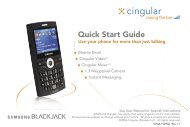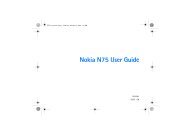You also want an ePaper? Increase the reach of your titles
YUMPU automatically turns print PDFs into web optimized ePapers that Google loves.
104<br />
Safety Guidelines<br />
10 Driver Safety Tips<br />
Your wireless phone gives you the powerful<br />
ability to communicate by voice almost<br />
anywhere, anytime. An important responsibility<br />
accompanies the benefits of wireless phones,<br />
one that every user must uphold.<br />
When operating a car, driving is your first<br />
responsibility.<br />
When using your wireless phone behind the<br />
wheel of a car, practice good common sense<br />
and remember the following tips:<br />
1. Get to know your wireless phone and its<br />
features such as speed dial and redial.<br />
Carefully read your instruction manual and<br />
learn to take advantage of valuable features<br />
most phones offer, including automatic redial<br />
and memory. Also, work to memorize the<br />
phone keypad so you can use the speed dial<br />
function without taking your attention off the<br />
road.<br />
2. When available, use a hands-free device. A<br />
number of hands-free wireless phone<br />
accessories are readily available today.<br />
Whether you choose an installed mounted<br />
device for your wireless phone or a speaker<br />
phone accessory, take advantage of these<br />
devices if available to you.<br />
3. Position your wireless phone within easy<br />
reach. Make sure you place your wireless<br />
phone within easy reach and where you can<br />
reach it without removing your eyes from the<br />
road. If you get an incoming call at an<br />
inconvenient time, if possible, let your<br />
voicemail answer it for you.<br />
4. Suspend conversations during hazardous<br />
driving conditions or situations. Let the<br />
person you are speaking with know you are<br />
driving; if necessary, suspend the call in<br />
heavy traffic or hazardous weather<br />
conditions. Rain, sleet, snow and ice can be<br />
hazardous, but so is heavy traffic. As a<br />
driver, your first responsibility is to pay<br />
attention to the road.<br />
5. Do not take notes or look up phone numbers<br />
while driving. If you are reading an address<br />
book or business card, or writing a “to-do”<br />
list while driving a car, you are not watching<br />
where you are going. It is common sense.<br />
Don’t get caught in a dangerous situation<br />
because you are reading or writing and not<br />
paying attention to the road or nearby<br />
vehicles.<br />
6. Dial sensibly and assess the traffic; if<br />
possible, place calls when you are not<br />
moving or before pulling into traffic. Try to




